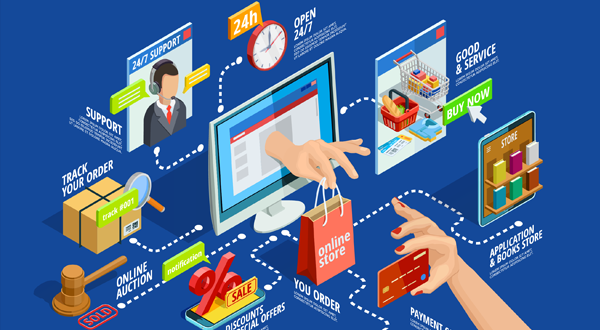The Olympic Games have long been a symbol of global unity, athletic excellence, and cultural celebration. Since their ancient inception in Greece, the Games have evolved into a massive international event, showcasing the pinnacle of human physical achievement and fostering a spirit of friendly competition. As we look forward to Paris 2024, the anticipation and…
Starting an E-commerce Business Without Products in 2024.
The E-commerce Business landscape has transformed dramatically over the past decade. With the rise of digital marketplaces, social media, and innovative technologies, starting an e-commerce business has become more accessible than ever. Interestingly, one doesn’t necessarily need to have physical products to kickstart an e-commerce venture. This guide explores various strategies and business models that enable aspiring entrepreneurs to start an e-commerce business without owning or stocking products.
1: Understanding E-commerce Business Models
Dropshipping
Dropshipping is a popular e-commerce model where the retailer does not keep goods in stock. Instead, customer orders are forwarded to a third-party supplier who then ships the products directly to the customer. Here’s how it works:
- Customer places an order: A customer visits your online store and makes a purchase.
- Order forwarded to supplier: The order details are automatically sent to your dropshipping supplier.
- Supplier ships the product: The supplier packages and ships the product directly to the customer.
Pros:
- Low startup costs: No need to invest in inventory.
- Scalability: Easily add new products to your store without worrying about storage.
Cons:
- Lower profit margins: Suppliers charge higher prices.
- Inventory issues: Reliance on suppliers can lead to stock inconsistencies.
Print on Demand
Print on Demand (POD) allows entrepreneurs to sell customized products such as t-shirts, mugs, and phone cases without holding inventory. Products are printed and shipped only after an order is placed.
Pros:
- Creative flexibility: Design unique products without upfront costs.
- Minimal risk: Products are produced and shipped as needed.
Cons:
- Higher production costs: Single-item production is costlier than bulk manufacturing.
- Quality control: Limited ability to oversee the printing process.
Affiliate Marketing
Affiliate marketing involves promoting products from other companies and earning a commission for each sale made through your referral link. This model requires a well-trafficked website or a strong social media presence.
Pros:
- No inventory or shipping: Focus solely on marketing.
- Passive income potential: Earn commissions on autopilot.
Cons:
- Competitive market: High competition in popular niches.
- Dependency on merchants: Earnings depend on the affiliate program’s terms and conditions.

2: Setting Up Your E-commerce Platform
Choosing the Right Platform
Selecting the right e-commerce platform is crucial. Here are some popular options:
- Shopify: User-friendly with extensive app integrations, ideal for dropshipping and POD.
- WooCommerce: A WordPress plugin offering flexibility and customization, great for affiliate marketing.
- BigCommerce: Scalable solutions for larger stores with advanced features.
Designing Your Store
A well-designed online store enhances user experience and drives sales. Key elements include:
- User-friendly navigation: Easy-to-use menus and search functionality.
- Responsive design: Mobile-friendly layout to cater to all devices.
- Compelling visuals: High-quality images and engaging product descriptions.
Integrating Payment Gateways
Secure and reliable payment gateways are essential. Popular options include:
- PayPal: Widely recognized and trusted by consumers.
- Stripe: Supports a variety of payment methods and currencies.
- Square: Ideal for integrating both online and offline sales.
3: Building Your Brand
Crafting a Unique Value Proposition
Your Unique Value Proposition (UVP) sets you apart from competitors. It should clearly articulate:
- What you offer: The core benefits of your products or services.
- How you solve a problem: The pain points your business addresses.
- Why customers should choose you: Distinct advantages over competitors.
Creating a Brand Identity
A strong brand identity includes:
- Brand name and logo: Memorable and reflective of your business ethos.
- Brand voice and messaging: Consistent tone and style across all communications.
- Visual aesthetics: Cohesive color schemes, typography, and imagery.
Social Media Presence
Leverage social media platforms to build your brand and connect with customers. Key strategies include:
- Content marketing: Share valuable and engaging content to attract followers.
- Influencer partnerships: Collaborate with influencers to reach a broader audience.
- Customer interaction: Respond to comments and messages to build trust and loyalty.

4: Marketing Strategies
Search Engine Optimization (SEO)
Optimize your website to rank higher in search engine results. Essential SEO practices include:
- Keyword research: Identify relevant keywords and incorporate them into your content.
- On-page SEO: Optimize titles, meta descriptions, and headers.
- Content creation: Regularly publish high-quality blog posts, guides, and product descriptions.
Pay-Per-Click (PPC) Advertising
PPC campaigns can drive immediate traffic to your site. Platforms like Google Ads and Facebook Ads offer targeted advertising options. Tips for effective PPC:
- Audience targeting: Define and reach your ideal customer demographics.
- Ad copy and visuals: Create compelling ads with strong calls to action.
- Budget management: Monitor and adjust spending to maximize ROI.
Email Marketing
Build an email list to engage with your audience directly. Effective email marketing strategies include:
- Lead magnets: Offer free resources or discounts to encourage sign-ups.
- Segmentation: Group subscribers based on interests and behavior for personalized emails.
- Automated campaigns: Set up welcome series, cart abandonment reminders, and promotional emails.
5: Leveraging Technology
Automation Tools
Utilize automation tools to streamline operations:
- Inventory management: Tools like Oberlo (for dropshipping) or Printful (for POD).
- Marketing automation: Platforms like Mailchimp or Klaviyo for email campaigns.
- Customer support: Chatbots and helpdesk software to manage inquiries efficiently.
Analytics and Reporting
Track and analyze your business performance using analytics tools:
- Google Analytics: Monitor website traffic and user behavior.
- E-commerce platforms: Use built-in analytics from Shopify, WooCommerce, etc.
- Third-party tools: Tools like SEMrush or Ahrefs for SEO and competitive analysis.
6: Managing Customer Relationships
Customer Service Excellence
Exceptional customer service can differentiate your brand. Key practices include:
- Prompt responses: Address customer inquiries and issues swiftly.
- Personalization: Tailor interactions to individual customer needs.
- Feedback collection: Regularly gather and act on customer feedback.
Building Customer Loyalty
Encourage repeat business through loyalty programs and incentives:
- Rewards programs: Offer points or discounts for repeat purchases.
- Exclusive offers: Provide early access to sales or special promotions for loyal customers.
- Community engagement: Foster a sense of community through social media groups or forums.
7: Scaling Your E-commerce Business
Expanding Product Range
As your business grows, consider expanding your product offerings. For dropshipping or POD, this involves:
- Market research: Identify trending products and customer demands.
- Supplier relationships: Build strong partnerships with reliable suppliers.
- Product testing: Introduce new products gradually and assess customer response.
International Markets
Explore international markets to reach a broader audience:
- Localization: Adapt your website and marketing materials for different languages and cultures.
- Shipping logistics: Partner with international shipping providers.
- Regulatory compliance: Understand and adhere to local regulations and taxes.
Advanced Marketing Techniques
Implement advanced marketing strategies to boost growth:
- Retargeting ads: Use retargeting to bring back visitors who didn’t convert initially.
- Affiliate programs: Launch your own affiliate program to incentivize others to promote your products.
- Content partnerships: Collaborate with bloggers and industry publications for guest posts and features.
Starting an e-commerce business without products is not only possible but also a viable and potentially lucrative endeavor. By leveraging dropshipping, print on demand, or affiliate marketing, you can build a successful online business with minimal upfront investment. Focus on choosing the right platform, building a strong brand, and employing effective marketing strategies to attract and retain customers. As your business grows, continuously seek opportunities to scale and expand your offerings. With dedication, creativity, and strategic planning, you can thrive in the dynamic world of e-commerce.
References
- Shopify. “What is Dropshipping and How Does It Work?” Shopify Help Center.
- BigCommerce. “The Ultimate Guide to Print on Demand.” BigCommerce Blog.
- HubSpot. “The Beginner’s Guide to Affiliate Marketing.” HubSpot Blog.
- Neil Patel. “Advanced SEO: A Complete Guide.” Neil Patel Blog.
- Google. “Google Analytics for Beginners.” Google Analytics Academy.
By understanding and implementing these strategies, you can embark on your e-commerce journey without the need for physical products, leveraging the power of digital technology and innovative business models to achieve success.




Very fantastic information can be found on weblog.Raise your business
Thank you for your sharing. I am worried that I lack creative ideas. It is your article that makes me full of hope. Thank you. But, I have a question, can you help me?